RECENT AUCTION SALES
LATEST AUCTIONS
At $1,595.00 the NAD 7600 Monitor Series Receiver was NAD's most expensive Receiver of the 1980's. It combined NAD's three top of the line separates (the 1300 Pre-amp, the 4300 Tuner and the 2600A Amplifier) into one chassis with a single transformer. It was also available with optional rack handles, with red inserts.
If you're curious about what vintage receiver puts out the most power, even for just an instant, this would be it. Stereo Review's Test Report found dynamic headroom of 5.1 db into 8 ohs and dynamic power output of 1,000 watts into 2 ohms, not to mention 800 watts into 4 ohms. "We were not tempted to test its almost limitless power reserves, out of consideration for our speakers and our ears, but there was no doubt that in terms of power this receiver is exactly what NAD claims it to be"....."the most powerful receiver on the market", just before Home Theater took over. And, that folks, is why the NAD 7600 belongs here.
The 7600, nominally rated at 150 w/ch RMS, was designed to compete directly with the Carver 2000, the Sony STR-GX10ES and the Luxman R-117, which are all competitors in my mind for the title of "Best Receiver of the 1980's". However, its "Power Envelope" circuitry produced higher levels of "tone-burst" power. According to NAD: "It maintains a clipping level above 500 watts per channel into the complex 4-ohm impedence that is typical of real loudspeakers." Also, in bridged mode a 7600 matched with a 2600A power amplifier "will deliver 3000 watts of dynamic power into a pair of such speakers".
The upper left photo shows my 7600 along teamed with the 2600A power amplifier, which are being used in "bridged mode", to produce their staggering dynamic range, which I dare not ever actually listen to!
What also sets the NAD 7600 apart from the competition was the inclusion of the very effective Schotz FM noise reduction circuitry. Another nice tuner feature is the analog-style tuning knob, rather than electronic buttons, which was impressively smooth in operation. In fact, one spin covers the entire range of FM stations. However, a distinct downside, is that the Balance control is all-electronic and there are 5 LEDs to guide you in centering.
 |
|
|
|
|
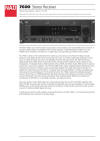 |
|
RECENT AUCTION SALES
LATEST AUCTIONS
The somewhat controversial successor to the Yamaha CR-2040, 1980's Yamaha R-2000 was rated at 30 w/ch RMS more (150 WRSM/ch vs. 120 WRMS/ch) yet weighed in at only 2/3 as much, making it the second most powerful of Yamaha's vintage receivers at only 10 WRMS w/ch less than the collosal CR-3020! The reason: the X-Processor (which first appeared in the M-70 amp.), which allowed for 3 db of dynamic headroom making a 30 lb. receiver sound like the real monster. The result was a receiver with just about as much power as the CR-3020, a superior digital tuner and that wouldn't break your back trying to move it around.
According to the R-2000's very detailed sales brochure: "A large portion of the performance loss and inefficiency in conventional amplifiers is due to the fact that the power output transistors are required to handle the full power supply potential evenwhen the amplifier is operating under small signal level - or even no signal level - conditoin. This excess power must be dissipated by the usual large finned heatsinks in order to prevent breakdown of the power transistor and unstable operation of the other components that are influenced by temperature variation. The "X" Power Amplifier overcomes this problem through a power level switching system that ensures the most stable, accurrate power amplification performance."
"Supply power is delivered to the "X" Power Amplifier in two levels: BH (High Voltage) and BL (Low Voltage). Special high-speed comparator circuitry monitors the level envelope of the audio signal and switches on the high-voltage supply only when required to handle high-level music peak - actually only a very small percentage fo total music time. Additional fast-rise detectors are incorporated to detect exceptionally fast-rising music transients and turn on the high voltage supply a little ahead of time so switching distortion cannot occur. A dely is also incorporated in the switch-down phase (BH to BL) completely eliminating the possibility of switching distorition. This system is so precise that even a single 100 kHz cycle at full 150 watt output power cannot cause distorition".
In concept, if not execution, this scheme was very similar to Carver's Magnetic Field Amplifer. Unfortunately, the X-Processor was also the 'Achilles Heel' of the R-2000 since it can get quite hot due to inadequate heatsinking. In fact, many owners (like me) glue computer CPU cooling fins on to it (with Loktite), which seems to cure the problem. Another questionable feature, the "Spatial Expander", sounds like nothing more than an echo-producing gimmick attempting to produce a wide soundstage. However, the way the brochure explains it make it sound much more sophisticated.
The R-2000 was also the first Yamaha Receiver with a digital tuner, although it was not Quartz Synthesized and instead relied upon proprietary comparator circuitry, which ultimately proved to be a dead end and not adpoted by other manufacturers. Contemporaries were the Pioneer SX-9, Sansui 9900, Kenwood KR-1000 Galaxy Commander and the Marantz SR-9000G. My R-2000 is shown at right atop the analog Yamaha CR-2040, that came immediately before it, for the sake of comparison.
Despite its shortcomings, the R-2000 got a glowing review from Leonard Feldman is Audio's test report (lower left). I've also included the R-2000 magazine ad, right top, so you can get a taste of how Yamaha marketed the R-2000. And, since it represents the cutting-edge tech for it's day, it is a favorite of mine. But, if you'd like to see what one is like inside, go here.
 |
 |
 |
|
RECENT AUCTION SALES
LATEST AUCTIONS
So, you must be wondering, why is this here? Well, it's a sentimental favorite of mine from my Sophomore year in college. The Lafayette LR-3500 was my first brand new Top of the Line receiver and I got it when I was a mere lad of 19 in 1974. So, it can fairly be said that my receiver collection started with this. I had previously owned a used Lafayette LR-1500TA, shown at right below the LR-3500, but was not attracted to it and did not keep it very long. The LR-3500, which I bougnt new however, I something was immensely proud of. It had a strong resemblance to the Pioner SX-1010 but cost about half as much.
As you can see, the LR-3500 was a HUGE step forward in styling from the LR-1500TA and more like a 4/5 size SX-1010, with about 1/2 the power. However, it looks even better to me because it does not have the SX-1010's row of frequently misaligned dark plastic teeth (buttons) below the tuner scale.
Althought it was Lafayette's flagship, the LR-3500 went up against the likes of the massively popular Marantz 2250, Pioneer SX-737 and Sansui 5000X in the mid-70's all competing in the fiercley marketed mid-priced league. Although it was only rated at 47 w/ch RMS, the 3500 had an excellent tuner and looked much more powerful, even including a dial dimmer button, just like the SX-1010.
And, it was (to my youthful eyes) gorgeous, with a complete set of illuminated function indicators, twin headphone jacks, solid machined metal knobs and it came standard with a real walnut veneer case, like the upper level Pioneer receivers, whereas the comparable Pioneer SX-737 had a woodgrain vinyl cabinet and the Marantz 2235 and the Sansui 5000X came only with utilitarian metal cabinets as standard. Mine (top, left) has had the dial lamps replaced with Tom Ishimoto's LED lamps. I think it was, without question, the most attractive of the bunch!
Sadly, I have never found a review of the LR-3500.
 |
 |
||||
 |
 |
||||
|
|
RECENT AUCTION SALES
LATEST AUCTIONS
The Marantz RS3559 sat atop Marantz's "Century Collection Receivers" for 1989 and and retailed for a cool $1,000, including elegant real rosewood veneer lacquered side panels. The "Century Collection" represented a major comeback attempt by Marantz from the downslide in the 80's and was developed while the Marantz USA brand was briefly owned by Dynascan Corporation, makers of the Cobra CB Radios. It also represented a return to desireability for Marantz, which really hasn't looked back since. However, the RS3559 is not really a Marantz, since it was actually made by Sansui since Dynascan didn't have the manufacturing capabilites for a such a sophisticated receiver.
But, TThe RS3559 is significant in that it was first legitimate Dolby Pro-Logic Surround receiver marketed under the Marantz brand. Given its DNA as a Sansui (manufacturer of some of the most coveted vintage stereo receivers, including the now insanely expensive Sansui 9090DB) as a "stereo", it was pretty impressive. Although nominally rated at a healthy 125 w/ch RMS in stereo, when tested by Stereo Review in their July 1990 issue, the main channels clipped at 178 watts at 1,000 Hz into 8-ohm loads. And. it also had considerable high current output capacity: in dynamic power tests, the 8-ohm output was 225 watts, increasing to 365 watt into 4 ohm loads and a truly "impressive" 305 watts at only 2-ohms. The review link has the complete set of "as tested" lab measurements.
The RS3559 also represented the return of Marantz's innovative "thermal tunnel" output transistor cooling design showcased in the legendary Models 2500 and 2600, where the heatsink for the output transistors is a horizontal enclosed structure with the cooling fins facing inward to create a tunnel effect. A 2 1/2 inch fan at the rear starts to turn slowly as the amplifier section warms up, drawing in air through the slots in the back, passing it over the fins, and expelling it through the bottom. As the temperture rises, the fan speeds up, but was never noticeable during Stereo Reivew's test.
The turner section features a total of 30 presets, which could be organized into three (3) groups, by type of music, or even by members of the household. Each of the stations could be "named" alpha-numerically as well.
The Dolby Pro-Logic Surround in the RS3559 was a big step up from the first generation Dolby Surround of the preceeding Marantz SR-3600, with many more options for adjusting the sound space, including digital delay and echo. Also, the RS3559 had five (5) seperate amplifiers, so you didn't need to bridge two (2) of them, like in the SR-3600, to get to 125 w/ch RMS in stereo, and give up the surround sound, without buying another external amplfier. However, given the relative lack of power in the extra amp. sections, the RS3559 should be considerated as primarily a stereo receiver.
The interior view, middle right, shows the relatively large, but conventional, power transformer and the metal-bladed cooling fan situated at the inner end of the "thermal tunnel", where it sucks in air from the back and pulls it through the tunnel.
Another interesting throwback feature was the inclusion of "Superscope FX sound, "which brings to the home music listening and theater experiences a highly effective combination of technologies", hailing back to the days in the early 70's when Marantz USA was owned by the owners of Superscope.
So, the RS3559 is worthy in that it represented a significant turning point in Maratnz's fortunes in the US and the company has never looked back since.
 |
|
 |
 |
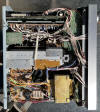 |
|
 |
 |
RECENT AUCTION SALES
LATEST AUCTIONS
The Yamaha R-100 was seen by many as emblematic of the "malaise" period for stereo receivers in the early 1980's. It was significantly smaller than the R-2000 that preceded it and gone were all the satin finish metal knobs, replaced by flat plastic-faced electronic controls. Rather than traditional heat sinks, cooling of the the output trasistors was accomplished through a freon-filled "cooling pipe" and heatsink combo, similar to the Kyocera R-851. However, as the follow-up TOTL to the R-2000, it was the "state of the art" for 1981 and offered several "firsts", in addition to being one of the earlist microprocessor-based receiver designs. It also has the distinction of being the first Yamaha receiver to also be available in a black face.......a sign of things to come.
In the Yamaha ad (lower left) the R-100 was discribed as "the most astouding, musical-sounding receiver ever to come from Yamaha. Or anyone." A bold proclamation indeed, which, if true, makes it very special. It carried over the R-2000's Auto Phono, Dynamic Noise Canceller (DNC), Spacial Expander and excellent RX'ing circuity. But gone was the controversial "X-Amplifier" module. It added a beautiful thick metal faced Remote Control, Yamaha's first, and the Comuputer-Controlled Sound System (CCSS), which was a fully electronic Graphic EQ with memory for three (3) custom settings, all controllable from the remote. This capability was truly on the "cutting edge" of consumer audio technology for 1981.
What was also particuarly notable about the R-100 was that it was the very first receiver to incorporate Yamaha's proprietary Zero Distortion Rule Amplificiation circuitry, previously available only on their component series amplifiers. This circuitry was devised to eliminate any distortion generated in the power amplifier stage by actually comparing the input signal to the output signal, determining which portions of the output signal were distortion - i.e. not present in the input signal, and summing the inverted distorion-only signal with the input signal so that the amplifier's distortion was effectively cancelled. This circuitry also obviated thermal distortion originating in the power transistors themselves, and distortion that normally arises due to back EMF (Electro-Motive Force) from the speakers.
Another intersting new feature introduced on the R-100 was the Dynamic Noise Canceller which increased the S/N ratio from any source, not just tapes. It differed from the ubiquitous Dolby noise reduction in that it incorporated a sliding low-pass filter that automatically followed the upper limit of the program frequency content and filtered out any noise above the highest frequency, while any noise within the program frequency range was eliminated by a pscyho-acoustic effect known as "masking". According to Yamaha: "The result is exceptionally quiet, noise-free reproduction from tape, disc or tuner."
Yamaha's exquisitely detailed R-100 brochure explains all the cutting-edge technology packed into this relatively modest unit. How could you not want one?
Although the R-100 was a bit of step down from the previous big Yamaha receivers, rated at "only" 100 w/ch RMS, it was still quite a performer, and had ample dynamic headrooom to boot. At normal listening volumes, it sounds pretty much indistinguishable from the R-2000 or the CR-2040 that came before it. I also used to have a CR-2020 (100 wpc) and CR-1000 (70 wpc), but that was long ago and I recall them as sounding rather sterile compared to the subsequent models, each of which introduced significant new amplifier/tuner technologies.
|
|
|
|
|
 |
 |
 |
 |
Lafayette LR-9090 (1977): 90x2 RMS
RECENT AUCTION SALES
LATEST AUCTIONS
The very conservatively styled Lafayette LR-9090 was the follow-up Lafayette TOTL recevier to the LR-3500 and, to my eyes, not nearly as appealing. It was one of horde that followed the clean silver faced styling of the Prioneer SX-1250, and featured almost double the power of the LR-3500. What makes it particularly noteworhty is that internally, it is essentially a Setton RS-660, although rated at 90 w/ch RMS (hence the name "9090"), as opposed to the RS-600's 120 w/ch RMS, and sold for only about half as much! (It also has the same unobtanium power/selector switch as the Setton.) Although not as fancy looking, the LR-9090 provides a similar user experience in both the sound quality and the feel the controls. As you can see from the Stereo Review test report (middle left), the LR-9090 tested quite well.
Although of little significance today, the LR-9090 came with Dolby FM Noise Reduction built-in (hence the Dolby logo on the front) whereas it was an optional accessory on the closely-related Setton. A comparison of the internals of the Setton RS-660 and the LR-9090, showing the obvious similarities between them is bottom, left.
Given that the LR-9090 was introduced in the very midst of the "Power Wars" it was not at the top of the Lafayette lineup for long, being replaced in short order by the 120 w/ch RMS Lafayette LR-120DB (supposedly made by Luxman). However, the 120DB looked nothing like the rest of the receivers in the Lafayette lineup and so it is something of an outlier and there is not much information about it, other than the ad, at right. I have owned two of them and my impression is that it was something of a "me too" product, lacking the overall finess and design fluency of the LR-9090.
With the passage of time, the LR-9090's clean, crisp design has held up fairly well, whereas the 120DB now looks somewhat ungainly and unfinished. Based on current eBay auctions, the LR-9090 is finally getting the recognition it deserves.
 |
|
 |
 |
|
|
 |
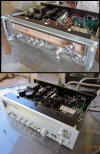 |
Luxman R-1120 (1976): 120x2 RMS
RECENT AUCTION SALES
LATEST AUCTIONS
The Luxman R-1120 was retailed at $895.00 but had about 25% less power than the similarly priced Pioneer SX-1250 at "only" 120 w/ch RMS. However, as a Luxman TOTL "tuner-amplifier" (not just a receiver, mind you!)it exuded a refined quality that the SX-1250 simpy couldn't match. It had same stying, in fact, as Luxman's incredible 120 lb. 300 w/ch RMS M-6000 power amplifier. I consider the R-1120 to be the most attractive of my vintage receivers, with its tasteful, minimalist design. It was a far cry from Luxman's first TOTL receiver marketed in the USA, the rather awkward looking FQ-990, also marketed in the US as the BIC/LUX 71/3R.
According to the ad, top right, the R-1120 introduced LED Power Meters, which quickly became an industry-wide trend. As a TOTL Luxman receiver, the R-1120 was tested by all the major audio magazines, as it would be a benchmark against which to compare the receivers of more mainstream manufacturers. Testing of the output power produced varying results.
According to the ad, top right, Consumer Guide found 130 w/ch RMS. High Fidelity found that "clipping does not occur until 22 1/2 dBW (170 watts) and the IME distortion stays low up to 23 1/2 dBW (228 watts). More than the 8-ohm rated power is available even into 16-ohm loads." And, Audio reported that it delivered 150 w/ch into 8-ohm loads at 1 kHZ before rated THD of 0.03 percent was reached. Of couse, Stereo Review tested it as well! Although the various test results were somewhat inconsistent, by any standard, the R-1120 is a powerful receiver, but certainly not a "monster".
The reason I don't have any photos of my own R-1120 is simple: it's still NIB (new in box) and has not yet seen the light of day (except, perhaps, through a window at the factory is was made in). I plan open it for my 80th Birthday celebration.
There was a follow-on model, the Luxman R-1120A, but there were significant differences between them. While the R-1120 had discrete output transitors, the 1120A, like the Pioneer SX-1980, had proprietary "power packs" with the consequence that they are pretty much irreplaceable. However, the R-1120A did have a pre-out/main-in which the 1120 did not. But, I'll take the discrete output transistors over the pre-out/main-in, thank you. So, the R-1120 belongs here.
 |
 |
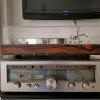 |
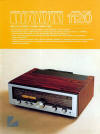 |
Yamaha CR-2040 (1979): 120x2 RMS
RECENT AUCTION SALES
LATEST AUCTIONS
The Yamaha CR-2040 is noteworthy as the very last of Yamaha's cherished silver-faced analog stereo receivers. It retailed for $859.00 and replaced the gargantuan CR-3020 (originally priced at $1,500.00) at the top of the line. It preceeded the digital tuner equipped R-2000 (shown top left atop of my CR-2040 for comparison). It was basically an upscaled version of the CR-2020 and the two had many similarities performance and feature-wise although, inside, they had almost nothing in common. The power was increased slightly from the CR-2020's 105 w/ch RMS to 120 w/ch RMS in the CR-2040. In fact, many erstwhile Yamaha collectors consider the CR-2040 as the "Queen" of Yamaha's vintage receivers with, of course, the CR-3020 as the "King".
However, sadly, the CR-2040 (at least those sold in the US) replaced the CR-2020's real walnut veneer case with an "ebony" walnut vinyl one, which cheapened the overall appearance and seems to attract assorted nicks and dings (from what I see in online photos). Some owners have even gone so far as to have a real wood veneer applied, which makes the CR-2040 look rather sensational, as in the photo lower right of a re-veneered CR-2020, but at the expense of being "all original", something most collectors highly value. I've decided to leave mine original.
On the inside, it's a much different story. The amplifier section appears to be significantly more muscular than the CR-2020's. Here's a good look. Although the CR-2040 came with all discrete components, the original Hitachi output transistors are no longer available but can be replaced wtih Sankens. But, please, leave that to a pro. If Yahama cut costs on the outside to improve the inside, then I am all in favor. However, it should be noted that the CR-2040 weighs in at a rather portly 46 lbs and is 23" inches wide, so it just won't fit into a lot of 20" wide cabinets.
 |
|
 |
|
 |
|
 |